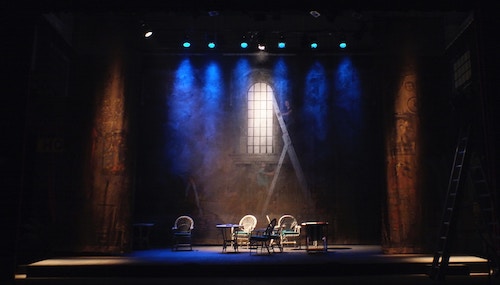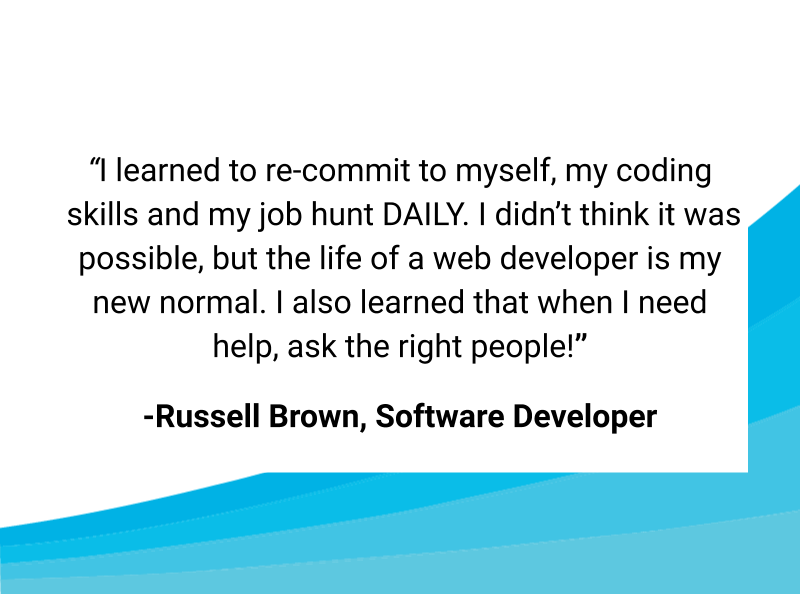How a Traditional Irish Dancer Discovered Software Engineering

Meet Flatiron student Russell Brown! He came to Flatiron School with a unique background, but quickly found home in the space of learning a new language. He has persevered and succeeded through adversity in his life to become one of the most inspiring stories we've ever featured. Here, Russell explains his journey: You have an […]

Meet Flatiron student Russell Brown! He came to Flatiron School with a unique background, but quickly found home in the space of learning a new language. He has persevered and succeeded through adversity in his life to become one of the most inspiring stories we've ever featured. Here, Russell explains his journey:
You have an interesting degree that I think we’d all like to know more about. Tell us what a Masters of Arts: Performance Studies/Irish Studies is all about? What led you to this interest?
I legit wanted to be a wizard, so a friend recommended I go into academia. Throughout my 20s I explored as many art forms and spiritual practices as I could, but my dream of professional wizard-hood was not working out. I looked to the careers of my idols, the authors Lewis, Tolkien, and Rowling, and realized academic inquiry was a sensible next step. I had been an Irish traditional musician and dancer my whole life, and a block from my apartment was a department of Irish and Irish-American studies at NYU. They admitted me with some scholarship support. While I explored history and performance studies, a field which birthed contemporary discourse on topics like gender and bio-politics, I kept dancing and making art.
You then went on to further your education in Ireland developing process-oriented approaches to dance, anthropology, and history. Tell us how these are all interconnected and what dance can reveal regarding these subjects.
While working towards my doctorate in Ireland, I studied a wildly different European and Australian practice-based research methodology that is not done here in the United States. Dance really leads the charge in this kind of research because some physical aspect of doing is essential, and you can’t do that without reflecting upon who you are as a person and where you came from. Add in the history, philosophy and the result is research that is not just intellectual but emotional and kinesthetic.
It’s clear you love dance and the arts. How did you make the jump from that love to coding?
When I started my master's degree, I walked into an Apple store and I started talking to the sales people on the floor and I realized that apps were the future of entertainment. I really wanted to become a software engineer in that moment but I thought it was too late. A few years later gave in to this desire and took a huge risk; I set aside my PhD and dance career and started teaching myself Swift/iOS. I was really relieved and excited when I found out coding is just choreography for computers. Dance, music and code all require discipline and lifelong commitment; they are crafts. In the end, coding liberated my research and helped me see that I had always been studying this human and technology thing.

I understand you have had some real challenges regarding poverty and disabilities. What can you share with us regarding that struggle and what strengths have you developed being faced with such adversity?
For the year I started teaching myself code, enrolled in bootcamp and was job hunting, I lived on just under $15,000 with three disabilities in New York City. Half the time I walked two miles each way to bootcamp, had not enough food and I had to borrow clothes. If I had a week where learning code was my biggest problem, I felt blessed. I had to also learn to accept the generosity of others. While the world can be an unfair place, there is a lot of kindness too. Flatiron School gave me a scholarship and ultimately set up my interview for the job I would receive and love. Since the life-changing day I got a job offer, I’ve learned I can use that education and experience to help others.
How have these life lessons of resilience translated into networking and becoming a Web Developer at Fortune Magazine?
I learned to re-commit to myself, my coding skills and my job hunt DAILY. I didn’t think it was possible, but the life of a web developer is my new normal. I also learned that when I need help, ask the right people! I learned not to unload my problems on my friends and family all the time. There are always the right people to support you in your journey to your personal finish line.
What is your advice to a student who is filled with doubt and fears about completing the Flatiron School program and finding a job?
You might struggle to do this…do it anyways. There's no time to feel defeated, press on. We don’t always get to choose our circumstances but we DO choose our lessons to move forward. You have seized this moment to rise up into a field unlike any that has come before. That’s a miracle. Stay true to your craft. The right job is waiting for you, needs you and can’t wait to meet you. The resilience you’ve learned in overcoming disadvantage will become a big advantage for you in tech. Your Flatiron career coach is really your number one cheerleader in your journey!
Russell's career coach Diane Fernandez on what made his job search so successful:
"There are 2 things that stand out about Russell's success with his job search. Firstly, he was open to feedback by asking questions and making adjustments as needed. Secondly, Russell was authentic in his approach to networking and communicating – he showed genuine interest in everyone he interacted with, as well as his coding! As a result, he seemed to have more ease in maintaining a connection with past interviewers which translated into someone reaching out for possible freelance work, and another company inviting him back to re-interview after an initial rejection."
Disclaimer: The information in this blog is current as of September 26, 2019. Current policies, offerings, procedures, and programs may differ.



